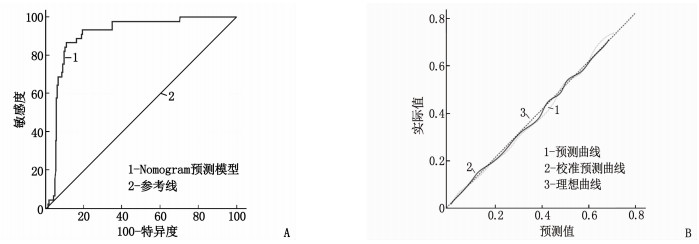Construction and evaluation of Nomogram prediction model for postoperative recurrence of pterygium
-
摘要:目的 分析甘南少数民族地区翼状胬肉患者术后复发的危险因素,根据结果构建Nomogram预测模型并进行评估。方法 以随机整群抽查的方式在甘南少数民族地区选取296例(296眼)经翼状胬肉切除术治疗的患者进行回顾性研究,根据患者术后1年复发情况分为复发组和未复发组。采用单因素及多因素Logistic回归模型分析影响翼状胬肉复发的危险因素。在此基础上构建Nomogram预测模型,绘制受试者工作特征(ROC)曲线及H-L拟合度曲线以评估模型的区分度及有效性。结果 本研究共纳入296例患者,其中术后1年复发者45例,复发率为15.20%。多因素Logistic回归模型分析结果显示,日间户外活动时间较长、内直肌止端距角膜缘距离较短、泪膜破裂时间短、合并干眼症是影响甘南少数民族地区翼状胬肉患者术后复发的独立危险因素(P < 0.05)。ROC曲线的曲线下面积为0.901, 敏感度、特异度分别为86.67%、88.84%(95%CI为0.826~0.924); H-L拟合度曲线显示拟合度良好(χ2=6.421, P=0.431)。结论 日间户外活动时间较长、内直肌止端距角膜缘距离较短、泪膜破裂时间短、合并干眼症是影响甘南少数民族地区翼状胬肉患者术后复发的独立危险因素。据此构建的Nomogram预测模型具有较好的区分度及有效性,可作为临床评估甘南少数民族地区翼状胬肉患者术后复发风险的有效工具。Abstract:Objective To analyze the risk factors of postoperative recurrence of pterygium patients in Gannan regions inhabited by ethnic groups, and to construct and evaluate the Nomogram prediction model based on results.Methods A retrospective study was performed for 296 cases (296 eyes) of patients with excision of pterygium in Gannan regions inhabited by ethnic groups in the way of random cluster sampling, and the patients were divided into recurrence group and non-recurrence group according to recurrence status at one year after operation. Univariate and multivariate Logistic regression models were used to analyze the risk factors of recurrence of pterygium. On this basis, a Nomogram prediction model was constructed, and receiver operating characteristic (ROC) curve and H-L fitting curve were drawn to evaluate the discrimination and effectiveness of the model.Results A total of 296 patients were included in this study, of which 45 recurred one year after operation, and the recurrence rate was 15.20%. The results of multivariate Logistic regression model showed that the longer daytime outdoor activities, short distance between the medial rectus muscle stop and the corneal limbus, short tear film rupture time and xerophthalmia were the independent risk factors affecting postoperative recurrence of patients with pterygium in the Gannan regionsinhabited by ethnic groups (P < 0.05). The area under the curve of ROC curve was 0.901, and the sensitivity and specificity were 86.67% and 88.84%, respectively (95%CI, 0.826 to 0.924); the H-L fitting curve showed there was a good fitting result (χ2=6.421, P=0.431).Conclusion Longer daytime outdoor activities, short distance between the medial rectus muscle stop and the corneal limbus, short tear film rupture time and xerophthalmia are the independent risk factors affecting postoperative recurrence of patients with pterygium in the Gannan regions inhabited by ethnic groups. The Nomogram prediction model constructed on these results has good differentiation and effectiveness, and it can be used as an effective tool for clinical evaluation of postoperative recurrence risk of pterygium patients in Gannan regions inhabited by ethnic groups.
-
Keywords:
- pterygium /
- risk factors /
- recurrence /
- Nomogram /
- prediction model /
- fitting curve /
- xerophthalmia
-
脊髓损伤会导致不同程度的躯体功能丧失,是瘫痪的最主要原因之一[1-2]。脊髓损伤最常发生于健康活跃的年轻人中,对个人、家庭和社会造成严重影响,所以部分身体功能的恢复也会对患者产生积极作用[3-4]。早期学者关注肋间神经移植术对截瘫的治疗,但发现疗效欠佳,该术式被逐渐废弃[5]。20世纪60年代日本学者TSUYAMA N等[6]首创肋间神经转位术,后来中国学者顾玉东[7]首创膈神经转位术、健侧C7神经根转位术,并应用在臂丛神经根性撕脱伤神经功能重建上,疗效确切[8]。此后,周围神经移位术开始广泛应用于脊髓损伤患者的神经功能重建。经过数十年的发展,神经移位术疗效得到大量的临床实践[9-12]所证实,成为脊髓损伤性瘫痪的首选治疗方法之一。本研究对国内外文献提到的有关重建脊髓损伤性瘫痪功能主要的神经移位方法进行综述,为脊髓损伤性瘫痪的治疗提供参考。
1. 理论基础
周围神经移位术是将原功能次要或能被代偿的自体周围神经,如肋间神经,或多根神经共同支配同一功能的其中一个分支,或支配某非关键部位功能的神经,移位至损伤的关键部位,重建损伤部位的神经功能[13]。早年间已有学者提出周围神经移位的理念,但缺乏形态学依据,直到20世纪晚期,才有学者[14]从形态学上证明外周神经移位能促进损伤神经元轴突再生。其中, 1996年CHENG H等[15]通过将大鼠的自体肋间神经移植到脊髓损伤的大鼠模型中,证实肋间神经移植能有效地促进神经轴突再生、突触形成,恢复神经功能。经过文献复习,其可能的机制如下: ①周围神经移位主要起引导和桥梁作用,促进轴突再生,并将孤立的神经元联系起来,与受损的神经元形成突触连接以达到信号的传导,重建神经功能; ②周围神经中含有多种细胞成分,如神经膜细胞、成纤维细胞及施万(Schwann)细胞等,这些细胞和轴浆能分泌细胞外基质和多种神经营养因子,具有保护和营养受损神经元,诱导轴突再生和促进神经元修复的作用[16-18]; ③周围神经中神经纤维的数量远超过靶组织所需的数量,多余部分被称为“周围神经功能储备”,这部分神经纤维可以在不影响效应肌功能的情况下作为供体神经使用[19]。因此周围神经移位术可以用于治疗脊髓损伤性瘫痪的神经功能重构。
2. 手术方式
神经移位的手术方式众多,临床上根据脊髓损伤平面、程度及患者需求等因素综合评定,结合术者的专业素养,选择合适的手术方式。
2.1 神经段移植嵌入嫁接术
高位脊髓损伤,如脊髓损伤、臂丛神经损伤,会导致一侧或两侧肢体痉挛性瘫痪,通过药物和物理疗法等保守治疗也难以缓解,此类患者需要外科手术治疗,以缓解痉挛或恢复部分肢体功能。
将脊髓损伤平面以上正常的周围神经,通过移位,与损伤的神经相吻合,可以重建部分神经功能,其效果在临床上已得到证实[20-21]。日本学者TSUYAMA N等[6]和中国学者顾玉东等[22]利用正常外周神经与损伤臂丛神经相吻合,但由于供体神经失活、移植纤维数量有限等原因,重建的神经功能亦有限。张少成等[23]首创神经移位嫁接术,其优势是只切断支配痉挛肌群的神经的部分纤维,在缓解痉挛的同时引入供体神经纤维,恢复部分正常神经支配,在重建功能的同时避免了选择性周围神经缩窄术的高复发率。研究人员将有限的供体神经纤维与支损伤的神经纤维吻合,在合适的平面上呈45 °角楔形切开受体神经,选择性切断部分受体神经纤维或神经束,切开供体神经的外膜和束膜,切断部分神经,将待植入的桥接神经一侧断端修剪成舌状,插入受体神经楔形切口内,另一侧与供体神经切口吻合,依次缝合束膜和外膜。保留剩余的受体神经纤维,使痉挛性瘫痪肌肉的非随意性收缩和肌张力得到部分保留,经术后康复训练使病理反射性收缩与重建的主动收缩同步,较直接吻合的术式更能增强重建神经所支配肌群的运动功能[24]。对于脊髓损伤性瘫痪患者的神经功能重建,首要是找到合适的供体神经,也是决定该手术疗效的关键。选择供体神经的原则有: ①与受体神经同性质,即释放的神经递质一致; ②神经转位后,对供体神经区原功能应不受影响或影响不大[25]。
对于胸段脊髓损伤性瘫痪患者而言,臂丛神经移植嵌入嫁接术是重建下肢、阴部神经功能的一种可行的治疗方法[26-28]。臂丛神经移位主要包括尺神经移位、桡神经移位和腋神经移位,其中又以尺神经移位术最具代表。尺神经是臂丛的主要神经之一,其作为供体神经所具备的优势有: ①神经纤维数量多,增加与受体神经连接的纤维量。神经轴突再生后,神经信号传导快,功能恢复程度显著[29]。②尺神经可游离距离长,移位后能缩短与受体神经的效应器官之间的距离,加速了重建神经功能的恢复[30-31]。③尺神经有独立的供应血管,在神经转位时,把该血管一并移位,可保证移位后尺神经的血供,防止移位后尺神经失活[32]。④通过骨间前神经旋前方肌支与尺神经深支吻合,桡神经浅支与尺神经浅支吻合,保证了尺神经手部功能不受影响[33]。张少成等[34]研究发现下段胸段脊髓损伤截瘫后,周围神经无显著变性,损伤平面以下脊髓尚完好,神经元完好,低级反射弧仍完整,即下肢周围神经仍保持着完整性,这为尺神经移位缝接马尾神经、坐骨神经、阴部神经等下肢周围神经重建部分功能提供了理论依据。
2.2 带血管周围神经移位术
20世纪初有学者将不带血供的肋间神经移位与腰神经根或马尾神经端-端吻合,与臂丛神经相比,肋间神经更适合作为供体神经[35]。但由于肋间神经纤维数量少,可游离距离短,仅适用于低位胸段脊髓损伤者,且移植神经容易缺血坏死,疗效欠佳,该术式未被推广。随后研究人员通过改良的带血供肋间神经游离移位,将正常的肋间神经及伴行的肋间动脉、静脉切断,注意保持肋间神经与血管无分离,并将近段端游离后经肌下遂道转移至椎管,分别与两侧选择性的腰1、2或腰2、3神经根的神经束或束组,在硬膜内或硬膜外相吻接,重建部分髂腰肌、股四头肌功能。同时,采用相同方式将带血管的肋间神经移位与S2~4神经根行选择性束间吻接,重建部分截瘫患者的排尿、排便功能,以及臀、会阴及外阴部感觉[36-37]。2007年研究人员通过带血供尺神经移位与股神经吻合重建陈旧性胸段脊髓完全性横断伤患者的部分下肢功能,疗效满意。由于需要肋间神经或尺神经移位术式的患者多数情况下神经移位距离较长,带血管神经移位可以很好地保证移位的供体神经不会缺血坏死,同时还可以促进神经再生。
2.3 神经束间侧-侧缝合术
为了改进传统端侧或端-端吻合术中存在的不足,如必须将受体神经切断,而对于一些难以分离断端或不能明确神经是否为完全性损伤患者而言,则不宜行端侧或端-端缝合,张少成首创神经束间侧-侧缝合术,通过动物实验证明周围神经侧-侧缝合后神经可再生,再生的质量与神经端侧缝合相当[38]。研究人员[39-40]将该术式用于陈旧性截瘫四肢瘫患者的感觉功能重建,疗效确切。通过把在解剖关系上邻近的正常神经干松解后,将其外膜和束膜切开,与经同样处理后的损伤神经行侧-侧缝合,供体神经可长出侧芽至受体神经内,且随着侧方切口的扩大和切开神经束的增加而新生侧芽神经纤维数量亦增加,且感觉功能的恢复优于运动[41-42]。其原因可能为,感觉功能的恢复所需神经纤维的数量要少于运动功能恢复所需的数量,尤其是只恢复到S2~S3级者。研究[43]证明,侧-侧缝合比端侧缝合神经纤维生长速度快,神经损伤后产生生长因子和诱导蛋白能促进正常神经纤维的生长,使其神经纤维长出侧芽,并与受损神经结融合。此外,由于侧-侧缝合后神经纤维向受损神经长出侧芽及生长快的特性,神经束间侧-侧缝合可用于预防高位神经损伤后不可逆肌萎缩[44]。因为神经再生速度每天仅1 mm左右,在此期间,靶向肌群长期处于失神经状态,缺乏神经营养作用,肌群会逐渐萎缩。另外,对于早期难以确定损伤程度而先采取保守疗法或无法早期手术治疗者,若待保守治疗无疗效后再行手术治疗,此时已错过神经修复的最佳时期。因此神经侧-侧缝合可以有效预防骨骼肌失神经性萎缩,同时亦不会对损伤神经内残存神经纤维的生长及传导通过缝合部位产生影响。
神经束间侧-侧缝合法作为一种新的脊髓损伤辅助或补充治疗,是全新的理念和方法,其具有手术操作简单、恢复快的优势。但是该术式干扰了正常的供体神经,应严格掌握其适应症,尤其是选择重要神经作为供体神经时,应慎重使用,因此该术式不可用于取代常规术式。
3. 手术适应证
目前神经移位术尚无统一的手术指征和适应症,根据既往研究[45], 主要依据患者脊髓损伤平面、程度、年龄以及手术意愿等多方面因素,结合患者实际情况选择不同的手术方式及供体和受体神经。①脊髓C1~4平面损伤,无自主呼吸或需要呼吸机支持且斜方肌肌力达3级者,可通过神经段移植嵌入嫁接术将面神经颈支或副神经移位吻接膈神经,重建膈肌自主呼吸功能[5]。②脊髓C5~8节段损伤,脊髓损伤四肢瘫痪1年以上,屈肘功能、手/腕功能、手内在肌运动或感觉功能未恢复,年龄 < 50岁者,可通过神经段移植嵌入嫁接术等术式,将副神经和颈丛移位吻接肌皮神经恢复屈肘功能,或将颈丛移位吻接臂丛内侧束恢复手/腕部分功能,或将胸外侧神经与尺神经缝合,将桡神经浅支或骨间前神经旋前方肌支移位与尺神经浅支缝合,重建尺神经支配的部分运动和感觉功能[46]。③胸段脊髓损伤,经非手术治疗1年后,会阴部感觉和尿便功能未恢复者,可通过带血管的尺神经移位与坐骨神经、阴部神经、股神经吻合,重建部分会阴感觉,改善排尿排便功能,或通过带血管肋间神经移位与股外侧皮神经、髂腹股沟神经或骶神经根选择性缝合,重建会阴部分感觉和排便功能[47]。④脊髓腰段平面损伤,经过治疗后下肢行走能力基本恢复,但足部或足底无感觉者,可通过神经段移植嵌入嫁接或神经束间侧-侧缝合术,将隐神经或腓肠神经移位与胫神经吻合,重建足部或足底痛温觉功能[48]。⑤骶髓平面损伤,经保守治疗6个月后尿便失禁无恢复,且臀肌肌力>3级者,可通过带血管肋间神经与阴部神经吻合,或通过神经段移植嵌入嫁接或神经束间侧-侧缝合术将臀上/下神经与阴部神经缝合,重建部分尿道、肛门括约肌功能,改善尿便功能[49]。
4. 总结与展望
脊髓损伤是导致瘫痪的主要原因之一,现如今还不能完全修复脊髓损伤,但随着医学技术不断发展,已经有越来越多针对性强且有效的治疗方法面世。手术治疗除了神经移位术以外,还有减压手术、神经松解术、肌腱移位等[50]。除此以外,还有间充质干细胞治疗、神经干细胞治疗,可以促进轴突再生,改善中枢神经系统抑制性环境[51-53]。神经移位术作为脊髓损伤性瘫痪功能重建的主要治疗方式之一,效果确切。本研究对神经移位术治疗脊髓损伤性瘫痪的机制、发展、主要术式及适应症进行综述,对临床工作具有一定的指导意义。未来相关的研究方向应制定神经移位术治疗脊髓损伤性瘫痪的指南,进一步明确手术指征及适应症,提高治疗效果,为脊髓损伤性瘫痪患者带来福音。
-
表 1 影响甘南少数民族地区翼状胬肉术后复发的单因素分析[(x±s)[n(%)]
因素 复发组(n=45) 未复发组(n=251) χ2/t P 年龄/岁 50.21±4.21 45.01±4.01 9.479 0.001 性别 男 18(40.00) 89(35.46) 0.341 0.559 女 27(60.00) 162(64.54) 工作环境 户外工作 40(88.89) 178(70.92) 6.351 0.012 室内工作 5(11.11) 73(29.08) 日间户外活动时间/h 6.43±2.56 5.14±2.04 3.748 0.001 饮酒史 14(31.11) 68(27.09) 0.308 0.579 吸烟史 12(26.67) 56(22.31) 0.409 0.522 合并高血脂 15(33.33) 59(23.51) 1.965 0.161 合并糖尿病 13(28.89) 63(25.10) 0.287 0.592 合并高血压 16(35.56) 65(25.90) 1.791 0.181 干眼症 20(44.44) 41(16.33) 18.429 0.001 剥脱综合征 6(13.33) 20(7.97) 0.000 0.988 睑板腺功能障碍 12(26.67) 80(31.87) 0.483 0.487 内直肌止端距角膜缘/mm 4.62±1.58 5.43±1.89 2.709 0.007 长入角膜缘内距离/mm 3.22±0.56 3.15±0.51 0.835 0.404 胬肉分期 活动期 31(68.89) 170(67.73) 0.024 0.878 静止期 14(31.11) 81(32.27) 胬肉性质 复发性胬肉 32(71.11) 200(79.68) 1.891 0.388 假性胬肉 4(8.89) 19(7.57) 原发性胬肉 9(20.00) 32(16.33) 发病时间/年 9.65±2.47 8.96±2.23 1.880 0.061 体质量指数/(kg/m2) 25.32±3.57 24.85±3.42 0.843 0.400 术前胬肉大小/mm 3.46±0.78 3.27±0.71 1.628 0.105 患眼 左眼 32(71.11) 152(60.56) 1.807 0.179 右眼 13(28.89) 99(39.44) 散光度/D 术前3个月 3.32±0.67 3.15±0.62 1.673 0.095 术后3个月 1.41±0.31 1.49±0.37 1.366 0.173 泪膜破裂时间/s 8.42±1.68 9.23±2.14 2.849 0.005 表 2 甘南少数民族地区翼状胬肉术后复发的独立危险因素的多因素Logistic回归分析
因素 B SE Wald P OR 95%CI 日间户外活动时间较长 0.319 0.088 13.138 0.001 1.377 6 1.158~1.636 内直肌止端距角膜缘距离较短 0.349 0.140 6.229 0.013 1.418 0 1.078~1.865 泪膜破裂时间短 0.267 0.103 6.702 0.010 1.360 0 1.067~1.599 合并干眼症 1.766 0.389 20.598 0.001 5.848 0 2.728~12.539 常量 -8.265 1.426 33.603 0.001 0.001 0 — -
[1] HU Y J, ATIK A, QI W, et al. The association between primary pterygium and corneal endothelial cell density[J]. Clin Exp Optom, 2020, 103(6): 778-781. doi: 10.1111/cxo.13049
[2] 包鹤龄, 方利文, 王临虹. 1990-2014年中国40岁及以上人群慢性阻塞性肺疾病患病率Meta分析[J]. 中华流行病学杂志, 2016, 37(1): 119-124. doi: 10.3760/cma.j.issn.0254-6450.2016.01.026 [3] 罗正才, 杨云. 翼状胬肉切除术联合自体角膜缘干细胞移植术的效果观察[J]. 实用临床医药杂志, 2021, 25(6): 42-44. doi: 10.7619/jcmp.20200083 [4] 陈百华, 闫滨, 彭立, 等. 翼状胬肉切除术中移植物的类型及其固定方式[J]. 中华眼科杂志, 2020, 56(2): 155-160. doi: 10.3760/cma.j.issn.0412-4081.2020.02.015 [5] COSTA F Q, COSTA R Q, BARBOSA J B, et al. Pterygium surgery with conjunctival autograft fixation using bipolar electrocauterization[J]. Eur J Ophthalmol, 2021, 31(3): 1458-1462. doi: 10.1177/1120672120965488
[6] 饶远生, 王建宏, 刘海鹰, 等. 冠心病患者行甲状腺手术围术期使用低分子肝素桥接的安全性分析[J]. 中国医药, 2021, 16(6): 869-872. https://www.cnki.com.cn/Article/CJFDTOTAL-ZGYG202106017.htm [7] 李科毅, 温杏芳, 付浩祥, 等. 缝针侧刃代替线剪在翼状胬肉切除联合自体结膜瓣移植手术中的应用[J]. 中国医学创新, 2017, 14(9): 70-73. doi: 10.3969/j.issn.1674-4985.2017.09.020 [8] 张俊芳, 杨梅, 朱蓉嵘, 等. 江苏省阜宁县农村50岁及以上人群翼状胬肉流行病学调查及相关危险因素分析[J]. 中华实验眼科杂志, 2019, 37(3): 212-217. doi: 10.3760/cma.j.issn.2095-0160.2019.03.010 [9] 杨梅, 管宇, 康丽华, 等. 中国40岁及以上人群翼状胬肉患病率Meta分析[J]. 中华实验眼科杂志, 2019, 37(3): 190-196. doi: 10.3760/cma.j.issn.2095-0160.2019.03.006 [10] 中华医学会. 临床诊疗指南: 眼科学分册[M]. 北京: 人民卫生出版社, 2012: 7-41. [11] LIU L, WU J Y, GENG J, et al. Geographical prevalence and risk factors for pterygium: a systematic review and meta-analysis[J]. BMJ Open, 2013, 3(11): e003787. doi: 10.1136/bmjopen-2013-003787
[12] 陶丽惠, 宋峰伟. 翼状胬肉切除联合自体结膜瓣移植术中两种缝合方式对术后角膜愈合及疼痛分析[J]. 国际眼科杂志, 2017, 17(10): 1960-1962. doi: 10.3980/j.issn.1672-5123.2017.10.42 [13] 雷新建. 翼状胬肉切除联合角膜缘干细胞移植术与单纯翼状胬肉切除术对翼状胬肉患者治愈与复发及术后恢复的影响观察[J]. 贵州医药, 2020, 44(4): 613-615. doi: 10.3969/j.issn.1000-744X.2020.04.041 [14] 孙莉, 李霞. 翼状胬肉流行病学及发病机制研究进展[J]. 广西医科大学学报, 2017, 34(1): 132-135. https://www.cnki.com.cn/Article/CJFDTOTAL-GXYD201701039.htm [15] SHIBATA N, ISHIDA H, KIYOKAWA E, et al. Relative gene expression analysis of human pterygium tissues and UV radiation-evoked gene expression patterns in corneal and conjunctival cells[J]. Exp Eye Res, 2020, 199: 108194.
[16] 胥婷婷, 朱华丽, 刘蓓, 等. 高原地区翼状胬肉患者术后复发的危险因素分析及预测指数模型构建[J]. 实用医院临床杂志, 2019, 16(5): 57-60. https://www.cnki.com.cn/Article/CJFDTOTAL-YYLC201905017.htm [17] 李梦琪, 李璇, 应阿珣, 等. 原发性翼状胬肉与干眼相关性的临床研究[J]. 河北医药, 2017, 39(3): 468-470. https://www.cnki.com.cn/Article/CJFDTOTAL-HBYZ201703043.htm [18] 刘鹏里. 胬肉术后复发危险因素Logistic回归分析及复发概率风险预测模型的构建[J]. 中国医学创新, 2019, 16(31): 129-132. https://www.cnki.com.cn/Article/CJFDTOTAL-ZYCX201931036.htm [19] 曾志芳. 翼状胬肉切除联合角膜缘干细胞移植术治疗翼状胬肉患者的效果[J]. 医疗装备, 2018, 31(22): 5-6. https://www.cnki.com.cn/Article/CJFDTOTAL-YLZB201822005.htm





 下载:
下载:

 苏公网安备 32100302010246号
苏公网安备 32100302010246号
